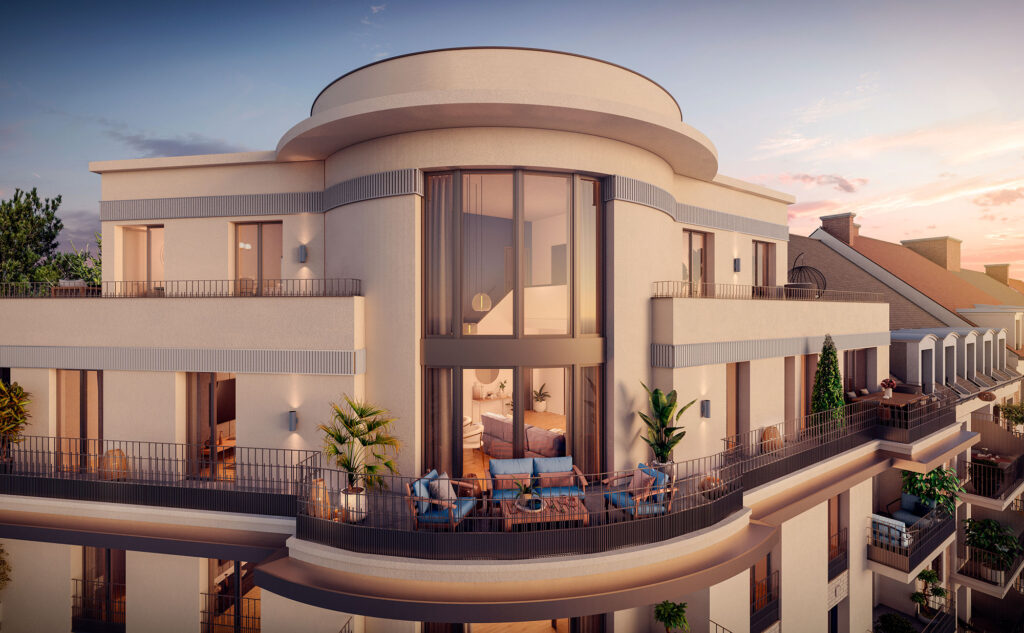In the age of Internet video formats, 3D real estate animation is taking on a prominent role in marketing strategies. It enhances immersion and arouses interest more quickly than a static image.
There are a number of ways in which animations can be enhanced to make the most of them and turn them into a real driver of communication. In this article, you'll discover the techniques and tricks you can use to enhance a 3D real estate animation.
3D animation: working with movement, light and texture
The realism of a 3D animation video is crucial to help viewers immerse themselves in the heart of your real estate complex. The best technique for 3D animation is to create an immersive, realistic and convincing experience.
Unlike a static image, an animation needs to be worked on in depth to be convincing, whether through the choice of camera angles, visual effects or scenarios.
The camera is an essential element in a 3D environment, as it guides the viewer's eyes. This provides a subtle yet effective way of highlighting the key elements of your real estate project.
What's more, lighting management brings maximum realism to your 3D animation. Working with light is particularly delicate, as its use impacts the understanding of the entire scene.
A 3D animator works differently depending on the light source to be simulated: natural light (sun, moon) or artificial light (streetlamps, lamps, candles).
With the right lighting, it's possible to accentuate the strong points of a building complex, or create a specific atmosphere in the space.
Among the tips for successful, realistic 3D animation, texture and materials must be closely considered. To immerse your prospects in the heart of your real estate program, furniture, walls and decor must be realistic and true to life.
For plausible animation, textures must have the right roughness and transparency. This enables the texture of wood, glass, leather or tiles to be faithfully conveyed. This guarantees maximum immersion in the real estate program under construction.
3D animation: creating engaging scenarios

3D animation really takes off when combined with a marketing technique: storytelling. Storytelling is the art of developing an engaging narrative for your audience. Today, storytelling is an integral part of real estate developers' communication strategies.
A vector of emotion
Instead of a simple animated video presentation of your real estate project, it's possible to take communication to a higher level by arousing the viewer's emotions.
The idea is to create a real scene around the history of the property. The animation offers a glimpse of the project's advantages, and becomes fixed in the viewer's memory.
Storytelling and 3D animation combine to create a real narrative that captures the audience's attention and holds it to the end. You can work on one plot or several storyboard stages.
Storytelling in 3D animation can be achieved in a number of ways: the use of the camera, music, voice-over and lighting.
Camera movement
The right use of the camera enhances your real estate storytelling. It will take your video from a simple teaser to an infatuation machine.
The use of light
Light plays a tangible part in the emotions felt by the viewer. 3D animation is an excellent way of triggering these emotions by creating a warm, welcoming atmosphere. This kind of detail in animation makes all the difference, as it helps to arouse the intention to buy.
In addition to the ambience, the lighting technique visualizes the transition from day to night in a 3D animation. This provides a visual history of an entire day spent in the complex, maximizing the possibility of projecting oneself into it.
Music and sound
Storytelling and animation technique can be taken to another level with a good soundtrack. The choice of music is crucial to immerse the viewer and convey the atmosphere of the future complex.
The progression of the music can accompany the narration, reinforcing the message sent to potential buyers. Sound effects also contribute to this realism: footsteps, cars, the voices of children playing in a park.
This element, far from being insignificant, provides additional immersion and engages your prospect.
The voice-over
Using voice-over also helps to effectively unfold your story and your message. In this way, you can unfold a storyline and challenges, while advancing the solutions your real estate program provides.
So storytelling is a crucial element in making 3D animation more engaging and more saleable.
3D animation video: using characters and objects
Using human characters is an excellent technique for enriching your 3D animation. They can be static or moving, depending on your needs. Their use facilitates the projection of viewers into the real estate program.
For example, the sheer size of the character gives an idea of the dimensions of the pieces, providing potential buyers with the keys to a decision.
What's more, characters are a great way of adding realism to your 3D animations. They also bring the video to life. Characters in action add an extra touch of dynamism that arouses the interest of prospects.
One 3D animation technique, for example, involves animating characters who walk around the room, sit on a sofa or work in front of a computer. In some cases, a main character can offer your prospects a guided tour.
Characters are essential marketing elements. You can choose characters who represent your core target audience, thus showing them the advantages of your real estate program.
That's why our graphic designers can create a set of characters that match your marketing target: families, couples, office workers, store managers or restaurateurs.
You have a multitude of choices to make sure you trigger the interest of the right people.
This technique works perfectly for both long animations and teasers.
3D animation: use of recommended software

Among the techniques required for successful 3D animation, it goes without saying that good software is essential. High-quality rendering software guarantees the immersion and professionalism felt when watching 3D animation.
Indeed, there's nothing less professional and less reassuring than chaotic animation with low-quality graphics. A number of software packages offer results to match your ambitions.
Blender
Blender is a software package that offers all the essential tools for modeling and animation. Highly efficient, it supports all realistic details for maximum immersion: liquid, fabrics, hair... It's a complete solution for 3D production.
3ds Max
When it comes to making 3D animated films, 3ds Max is both practical and complete. In particular, it excels at modeling buildings, complex environments and characters. For character animation, this software features advanced rigging, skeleton and morphing tools.
This powerful software can also be used for reverse cinematography and high-quality special effects.
Cinema 4D
Cinema 4D is a fast, stable tool that makes it easy to create professional-level productions. It offers the possibility of adjusting motion parameters and animating objects. For even more powerful animation, you can use motion graphics.
There are several techniques you can use to enrich and enhance your 3D real estate animations. They not only guarantee immersion, but also arouse the emotions of potential buyers.
It's a real marketing engine to help you sell your project to your core target audience.
Integrate 3D animations into your marketing strategy








